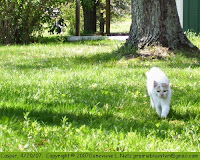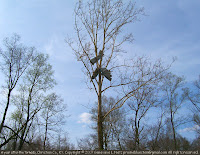Proper nouns allowed
Well, this is earthshaking news. Mattel has changed the rules of the board game, Scrabble.
The rules of word game Scrabble are being changed for the first time in its history to allow the use of proper nouns, games company Mattel has said.
Place names, people's names and company names or brands will now count.
Source: "Proper nouns come into play in Scrabble rule change", BBC News, April 6, 2010.
Later in the article, Mattel (a Mattel spokesperson, surely) says that there will be no rules about right or wrong spellings of proper nouns. It's hard for me to understand how that will work, but I guess it will be all right for those who want to play by those rules.
Keely and I have already decided that we will continue to play by the traditional rules. In our house, that means that no proper nouns at all are allowed.
The appearance of Scrabble in world news gives me an excuse to share our Easter afternoon Scrabble game. It was a good one! At the end of the game, we both had three letters left, and the score was 680 (Keely) to 756 (me). In a stunning moment of pure genius, Keely saw that she could play all three of her letters (E, I, and W) in the following location on the board.
The blank letter is a T. Do you see the place where Keely played? Click here to see the word that earned her 102 points and moved her to the lead, 782 to 770. (In anatomy, an iter is a passage or canal, particularly in the brain.)
I played my last three letters and got another 27 points, making the final score 809 to 782 in my favor. Looking at the completed game now, I don't even remember the places where I played. I won, but it hardly seemed a victory after Keely's spectacular coup.
That's how Scrabble is supposed to be played. Proper nouns would spoil everything!
UPDATE: It turns out that the U.S. version of Scrabble, owned by Hasbro, has not changed its rules. See the comments below for a link.

 My sister-in-law Kathy sent a link to
My sister-in-law Kathy sent a link to  How many robots have served you today? Chances are, you've used some kind of a money-handling robot. Perhaps it was the ATM machine, the self-check lane at the grocery store, or the pay-at-the-pump at the gas station.
How many robots have served you today? Chances are, you've used some kind of a money-handling robot. Perhaps it was the ATM machine, the self-check lane at the grocery store, or the pay-at-the-pump at the gas station. Another
Another 




 You might enjoy reading this AP story:
You might enjoy reading this AP story:  The old expression that "Birds of a feather stick together" is still correct, but it's apparently not inclusive enough. These little birds operate more like the Arab proverb, "My brother and I against my cousin. My cousin and I against the enemy."
The old expression that "Birds of a feather stick together" is still correct, but it's apparently not inclusive enough. These little birds operate more like the Arab proverb, "My brother and I against my cousin. My cousin and I against the enemy."